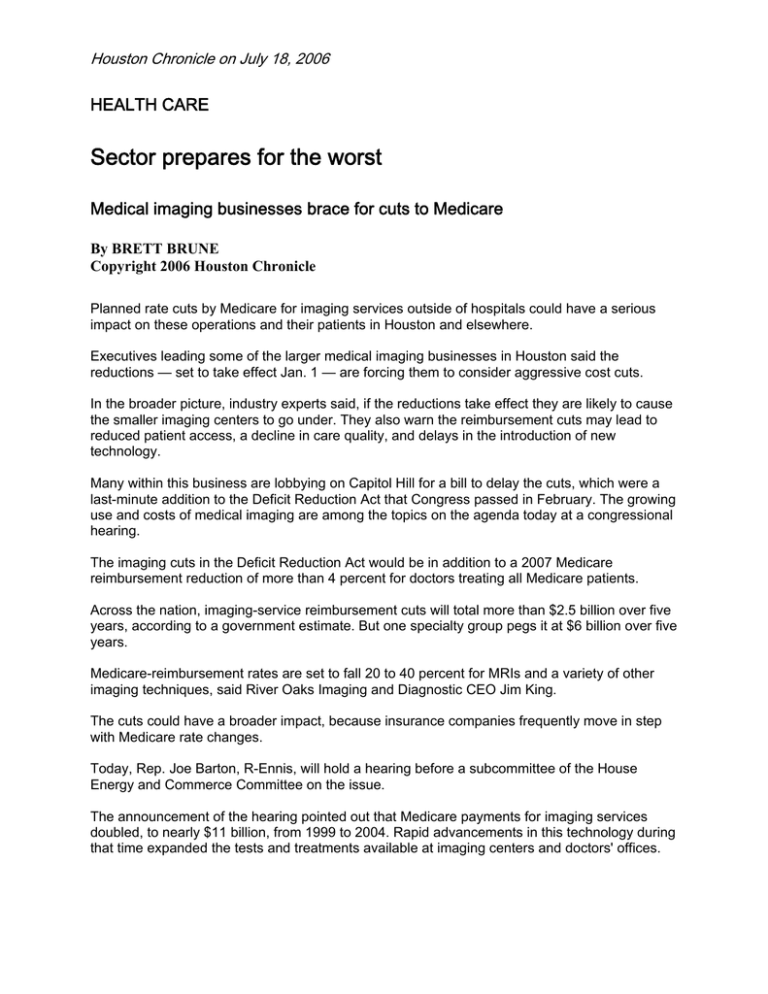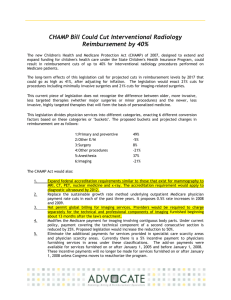Sector prepares for the worst HEALTH CARE
advertisement

Houston Chronicle on July 18, 2006 HEALTH CARE Sector prepares for the worst Medical imaging businesses brace for cuts to Medicare By BRETT BRUNE Copyright 2006 Houston Chronicle Planned rate cuts by Medicare for imaging services outside of hospitals could have a serious impact on these operations and their patients in Houston and elsewhere. Executives leading some of the larger medical imaging businesses in Houston said the reductions — set to take effect Jan. 1 — are forcing them to consider aggressive cost cuts. In the broader picture, industry experts said, if the reductions take effect they are likely to cause the smaller imaging centers to go under. They also warn the reimbursement cuts may lead to reduced patient access, a decline in care quality, and delays in the introduction of new technology. Many within this business are lobbying on Capitol Hill for a bill to delay the cuts, which were a last-minute addition to the Deficit Reduction Act that Congress passed in February. The growing use and costs of medical imaging are among the topics on the agenda today at a congressional hearing. The imaging cuts in the Deficit Reduction Act would be in addition to a 2007 Medicare reimbursement reduction of more than 4 percent for doctors treating all Medicare patients. Across the nation, imaging-service reimbursement cuts will total more than $2.5 billion over five years, according to a government estimate. But one specialty group pegs it at $6 billion over five years. Medicare-reimbursement rates are set to fall 20 to 40 percent for MRIs and a variety of other imaging techniques, said River Oaks Imaging and Diagnostic CEO Jim King. The cuts could have a broader impact, because insurance companies frequently move in step with Medicare rate changes. Today, Rep. Joe Barton, R-Ennis, will hold a hearing before a subcommittee of the House Energy and Commerce Committee on the issue. The announcement of the hearing pointed out that Medicare payments for imaging services doubled, to nearly $11 billion, from 1999 to 2004. Rapid advancements in this technology during that time expanded the tests and treatments available at imaging centers and doctors' offices. Cuts affect everyone The imaging cuts in the Deficit Reduction Act affect everyone, Tim Petrikin, chief executive of Nashville, Tenn.-based e+healthcare, said. Together, e+healthcare and St. Luke's Episcopal Health System own six imaging centers focused on cancer in the Houston area. "This is a serious issue that will hugely impact access," he said. "Hospitals are reimbursed in a different manner and can spread costs over many service lines. Diagnostic imaging centers can't. So it will be very difficult for them to continue to succeed and develop in new areas." On June 28, Rep. Gene Green, D-Houston, and 42 co-sponsors submitted a bill that seeks to delay the imaging cuts for two years and force the Government Accountability Office to examine the imaging business. ''There wasn't any study that said, 'Yes, we'll actually save this amount of money,' " Green said. ''If you make an automatic cut without knowing its impact, you could cut the meat instead of just the fluff in a program." "We're going more toward imaging" in all sorts of medicine, including cardiology, muscular skeletal, neurology and oncology, Green said. "This is probably not the time to make the cuts." Adding to the list of changes for imaging centers, doctors with investments in nuclear medicine imaging services at outpatient clinics must divest themselves by Jan. 1. A related conflict-of-interest rule, from the Centers for Medicare and Medicaid Services, is forcing St. Luke's and e+healthcare to buy out the doctors who invested with them in the six independent partnerships that run their PET Imaging centers. Petrikin said the buyouts are being negotiated by a third-party appraisal firm. ''Everybody understands in the health care world that these things happen," he said. ''They'll be bought out at a fair market value, and we'll continue to serve them and their patients." Growth rate The growth rate in imaging was the topic of a study the Lewin Group, a consulting firm in Falls Church, Va., conducted last year for the American College of Cardiology. Allen Dobson, an executive within the consultancy's health care finance practice, said the government ''has the impression that imaging is rising faster than other kinds of physician procedures" and worries about doctors who own imaging equipment ''over-referring" patients. ''The physicians argue that physician referral inside the physician office, ownership or otherwise, is appropriate and beneficial to the patient," he said, noting that patients sometimes can get images taken and interpreted the same day, and in the same office. ''As a payor, the government has to be asking itself, 'Is it appropriate and should we pay for it?' Some physicians, on the other hand, see this as an appropriate way of improving patient care," Dobson said. One argument against reducing the reimbursement for imaging services is that certain surgeries can be avoided by using imaging, because it helps doctors diagnose disease early and monitor whether therapy is working, said Nancy Davenport-Ennis, founder of the 10-year-old Patient Advocate Foundation. "Nobody wants to undergo invasive surgeries or long-term hospitalizations or to lose independence and functionality," especially if it's because they lack timely access to or cannot afford medical imaging services, she said. "That is the real-world effect of these cuts." Many services offered Freestanding, fixed outpatient imaging centers offer a wide range of imaging services, including CT (computed tomography) and PET (positron emission tomography) scans. Industry sources say there are more than 40 such centers in the Houston area. E+healthcare and River Oaks Imaging, two of the largest imaging center operators in Houston, say they will find ways to adapt. ''We're going to buckle up our chin straps and tighten things down as best we can," at River Oaks Imaging, which was started in 1989, King said. ''There's no way we're going to close any facilities." River Oaks Imaging, which has 10 free-standing imaging clinics in the Houston area, already has ''a pretty efficient operation," King said. ''But the reduction in reimbursements will have a dramatic impact on our profitability. And when we're less profitable, it makes it difficult for us to go out and invest in new technology, and to provide new locations for the people of Houston." Because the for-profit company can't fall back on grant or foundation money, ''this hampers our ability to grow and to meet the needs of our patients," King said. Less-established imaging clinics are more vulnerable to the promised cuts in Medicare reimbursement rates for imaging services, King said. ''We're the largest and most established imaging company in the market," he said. ''We can stand there and take a beating. If you're already in financial difficulty, taking a 20 percent cut in a major part of your business can have a devastating effect." The reimbursement cuts for imaging services and for doctors serving all Medicare patients, both coming Jan. 1, may cause upheaval at Woodlands North Houston Heart Center, which employs more than 60 people, including seven cardiologists, administrator John Henderson said. He figures the cuts will add up to a 10 percent reduction in revenue in one year. ''That's pretty drastic," Henderson said. ''That could be in excess of $1 million."







